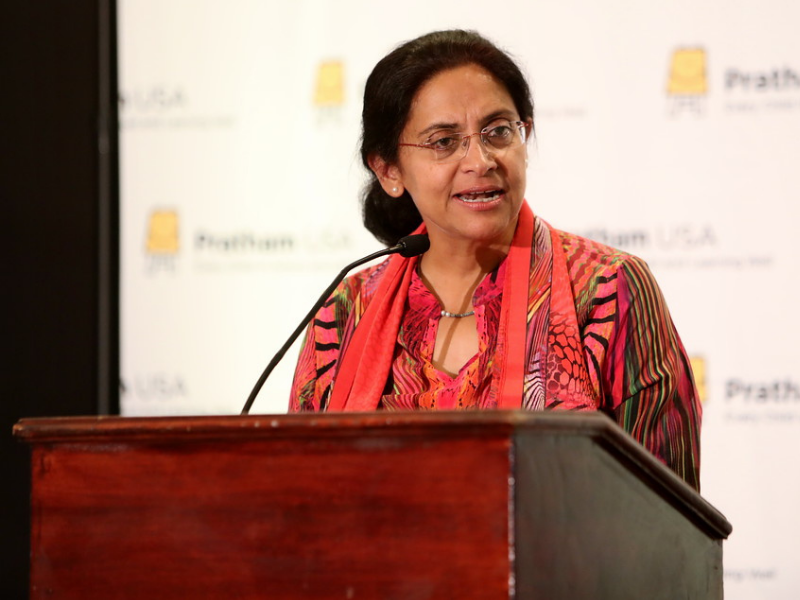– Dipta Joshi
Dr. Rukmini Banerji is the Chief Executive Officer of Pratham Education Foundation. A strong advocate of providing quality education to young learners, she was instrumental in setting up the organisation’s research and assessment activities. She was also director (2005-2014) of Pratham’s ASER Centre which conducts the nation-wide Annual Status of Education Report (ASER) survey. Speaking to Education World, Dr. Banerji outlines the fundamental lessons educators need to adopt to bridge the learning gaps among young learners once schools reopen.
How should educators and policy-makers approach in-class teaching once schools reopen?
Once schools reopen, teachers need to reconnect with children. In a relaxed way, simple activity-based assessment can be used to figure out their current level of learning, especially with regards to basic skills. The first 100 days after school reopening should focus on foundational skills like basic reading and arithmetic. Children need to “catch up” since they may have suffered learning loss during the lockdown. This ‘catch-up’ must be planned as an integral part of the school reopening protocol. We need a strong concerted effort to support schools, to be able to strengthen foundational skills. As schools reopen and attendance stabilizes, entire focus should be on ‘catch-up’ and not on rushing to finish the curriculum.
Children in Grades III and above will progress very quickly to get back to or even go beyond their earlier level when schools closed. This progress will bring positive energy to the entire system.
With the COVID-19 crisis accelerating digital transformation across the country, do you think our children might have adapted to digital learning hence reducing their dependence on physical presence of teachers?
Due to the COVID-19 crisis, schools have scrambled to connect to students through whatever digital inputs and resources available. In this process, children, parents and teachers have had a chance to interface with technology in different ways. Without COVID-19 such interactions may have taken another at least five years to happen. However, the question is not whether to choose technology over teachers; the real challenge is to figure out what is the right hybrid balance where digital mechanisms, resources and human efforts combine in the most effective manner to best meet each individual child’s needs. Even with remote learning or on-line classes, it is essential that there is a strong and direct connect between the teacher and the learner.
For the past six months, Pratham’s teams have been engaging remotely with children through daily activities and a once-a-week follow-up by a team member known to the child. We firmly believe that it is the two-way communication. The growing closeness between the family, the child and the person who is calling, all contribute to a child’s motivation to learn.
What fundamental lessons from the COVID-19 experience can we use in a post-COVID-19 situation?
Our own experiences during the crisis led to several learnings – ‘setting a clear goal’, ‘starting with the available resources’ and ‘maximising an opportunity while learning from it’. At Pratham, we systematically planned steps to reach our goal of reaching “every child” in every location where we had been working. We worked extensively with basic phones (to send out SMS) as well as used radio, both of which are “old” technologies and yet capable of reaching a much wider audience. We also realised the more you reach out, the greater response you get. Do not wait for the ideal situation to get started.
Another fundamental lesson from this experience is to “go back to basics”. The focus should be on helping children who have fallen behind to ‘catch up’ if we want to effectively address concerns about equity.
How did Pratham meet the COVID-19 challenge?
After years of working face to face with children in schools and communities, we had to quickly devise ways of reaching the children and engaging with them remotely during the lockdown. We were sending out close to one lakh SMS messages and another lakh WhatsApp messages each day. In early April we were reaching about 6000 villages but by late May, our reach had grown to almost 12,000 villages.
Having in-house digital content in 10 regional languages was a huge boon since we were able to use our own digital resources through the ‘prathamopenschool.org’ and share them with over 500 other organisations and 14 state governments. In collaboration with different governments, we have also developed and broadcast radio and TV programs.
Come to think of it, nothing was stopping us from scaling and reaching out to so many communities before COVID-19, but this unprecedented crisis has in fact helped us double the reach of our activities.
Read: Covid-19: Challenges faced by students and how are schools coping with it
Also read: Pratham Education Foundation aids students to resume education
Posted in Corporate, News


























